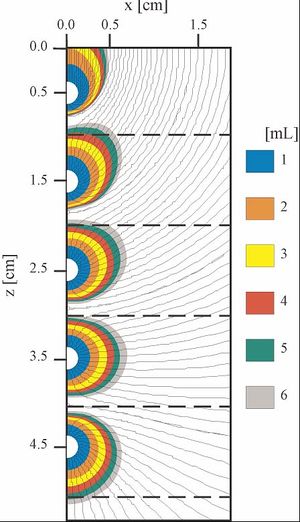Submarine groundwater discharge in coastal regions: development of a new sampling technique
Introduction

At least since the days of the Romans the discharge of freshwater from submarine springs has been known. Long overlooked and considered as a “local phenomenon”, several studies underlined the relevance of submarine groundwater discharge (SGD) during recent years. Associated with submarine groundwater discharge is the release of nutrients, xenobiotics, as well as trace gases. Furthermore, SGD affects hydrological budgets as well as land- side studies on groundwater renewal. Recent data compilations revealed the worldwide occurrence of SGD in coastal areas. For example, in the Mediterranean Sea a freshwater volume of more than 300 m3/s is discharged from the seafloor at a single site. For comparison, this amount is three times larger than the discharge by the river Ems.
For more information see: Submarine groundwater discharge
Methods & Techniques

In porous, sandy sediments of the North Sea and the Baltic Sea it is difficult to exactly locate the position of discharge sites. One way is to analyse the composition of porewater, the water filling the spaces between the sediment grains. But sampling of porewater in porous or sandy sediments is often a complex task, which requires new geochemical and geophysical techniques. For investigations of seawater and freshwater flow at freshwater discharge sites we developed the Rhizon In Situ Sampler (RISS, Fig. 1). This device can be deployed in shallow coastal zones but also in deeper waters near the continental margins. The key parts of our sampling device are Rhizons, which are used in soil research for sampling water in soils from the unsaturated zone. Rhizons are made of hydrophilic porous polymer tubes with a typical pore diameter of 0.1 µm. The outer diameter of a Rhizon is 2.4 mm and the filter section has a length of 5 or 10 cm. For the porewater sampling, in situ peristaltic pumps are applied. The entire sampling procedure is computer controlled. With laboratory experiments and by numerical modelling we investigated the minimal spacing of the sampling ports (Fig. 2). The in situ porewater sampling provides, due to its neglibile impact on the sediment structure, data for the modelling of freshwater flow at discharge sites. By these means the freshwater discharge was studied in the Wadden Sea at Cuxhaven (Fig. 4 and 5). In this region SGD occurs at distinct spots (“sand boils”) and diffuse flow over larger areas (Fig. 3). Associated with the discharge is the release of nutrients and of trace gases like radon and methane.
References
- ↑ Seeberg-Elverfeldt, J., Schlüter, M., Feseker, T. & Kölling, M. (2005). Rhizon sampling of pore waters near the sediment/water interface of aquatic systems. Limnology and oceanography: Methods, 3, 361-371.
Please note that others may also have edited the contents of this article.
|
Please note that others may also have edited the contents of this article.
|
Please note that others may also have edited the contents of this article.
|


